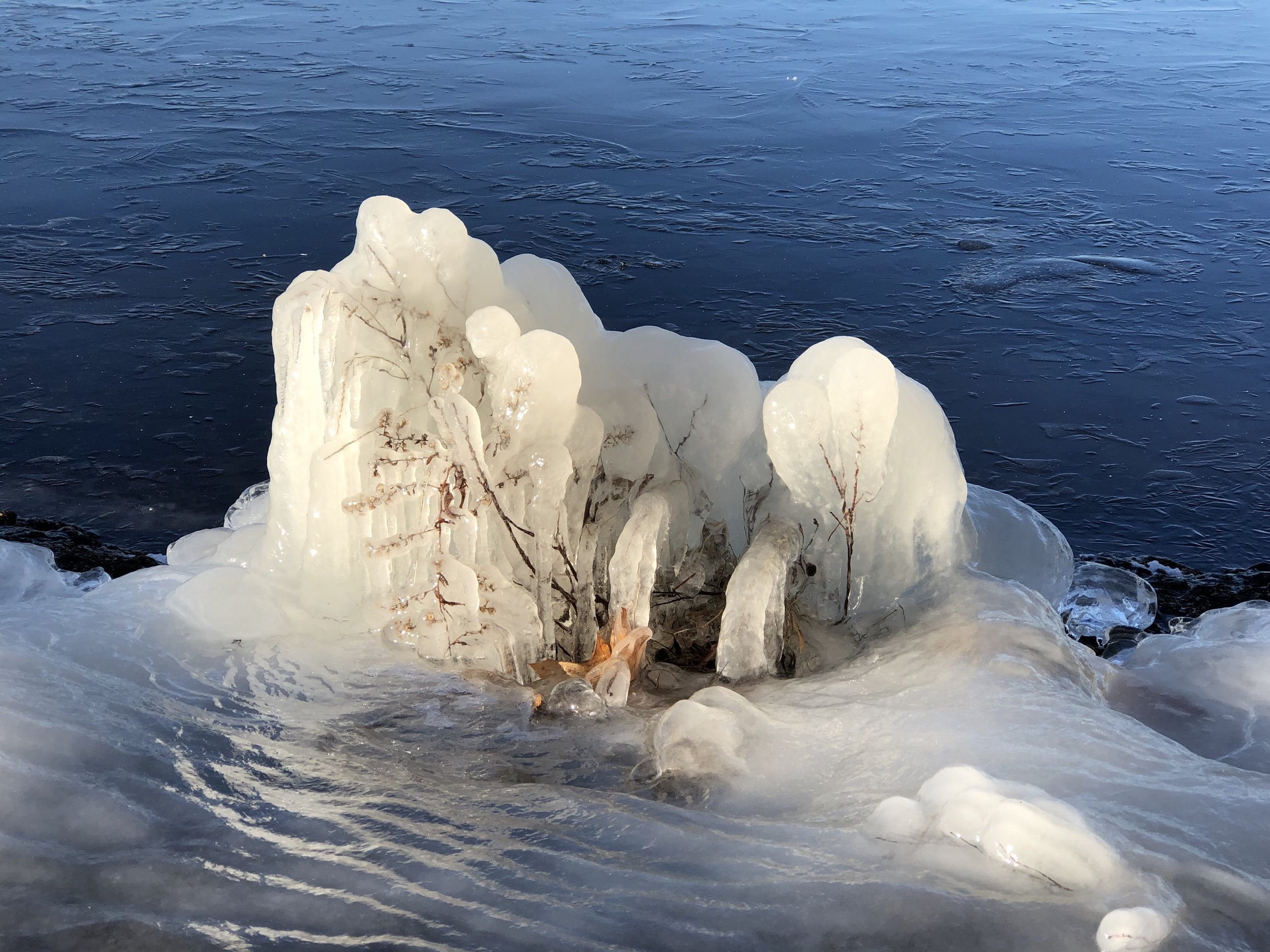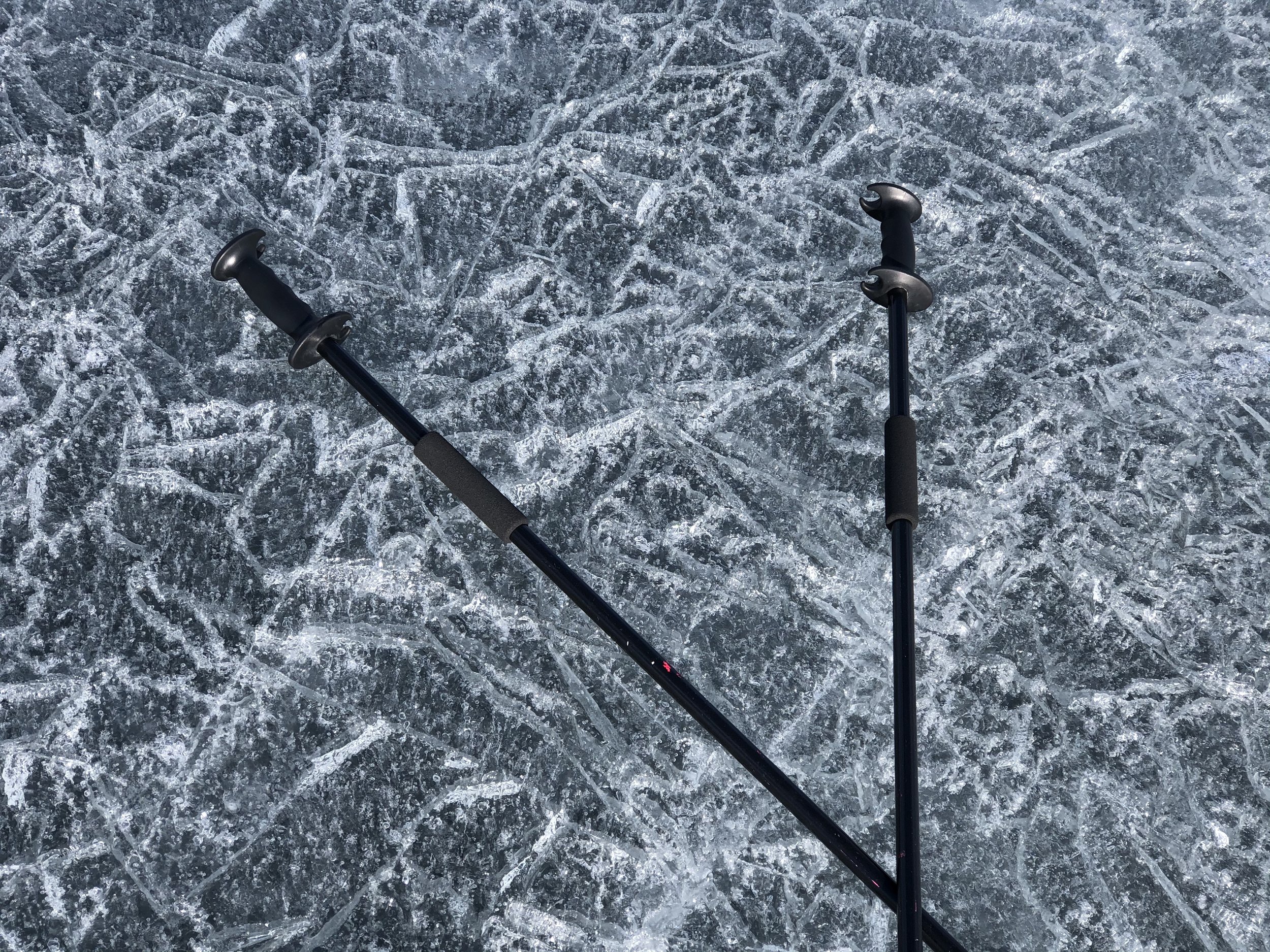Black Ice
The ‘holy grail’ for wild skaters, black ice is the hardest, smoothest and most visually stunning. It’s also the most ephemeral, as any form of precipitation will cause it to lose its blackness.
Black ice is formed from lake and river water - in contrast to gray and white ice, which are formed from precipitation. (More about gray and white ice later.)
Black ice isn’t really black, it’s transparent. It’s a window onto the lake bottom, which is usually dark in color. But when the lake is shallow and the bottom is sandy, black ice will appear yellow or brown, depending on the depth and color of the water.
Reading black ice is all about looking for cracks and air bubbles within the ice, and watching for variations in surface texture and reflectivity.
As long as nighttime temperatures are in the teens or lower, new black ice typically grows by 3/4 inch per night for the first four nights. Ice growth then slows down gradually as the ice sheet gets thicker.
Brand-new black ice can be spotted easily because it has neither cracks nor bubbles. And it must be avoided. After the second cold night you may start to see trapped air bubbles, which rise slowly from the lake bottom and become encased in the growing ice sheet. But if there are no cracks, the ice isn’t safe yet.
After the third cold night, you may begin to see a web of cracks that form naturally at night as the ice cools and shrinks. (It can take more than three nights if the nights aren’t very cold.) These cracks fill with water as soon as they form, and that water usually freezes immediately to strengthen the surrounding ice sheet. Three-night-old black ice with naturally-occurring cracks (not the cracks that form when you stand on it!) is theoretically safe for a solo skater if the air temperature is below freezing and the sun is weak or absent. It’s also safe for a group of skaters if each skater maintains a separation of 10 meters or 30 feet away from all others at all times. But for a group of skaters who like to congregate together, black ice must be at least four nights old and three inches thick.
You can quickly gauge the thickness of black ice by looking at the cracks from the side and seeing how far down they go. Air bubbles, frozen fish and other impurities can give you the same information, but cracks are the easiest. And they have a built-in safety margin, because the ice is always thicker than the cracks suggest.
Cracking and singing
It’s natural for black ice to crack underfoot, but those cracking sounds can take some getting used to. When you skate you’re exerting a lot of force on a very small area, just the width of your skate blade, and you’re making the ice sheet bend under you. Ice doesn’t like to bend, so instead it cracks.
Think of ice as like a raft floating on the water. If the raft is big enough it will hold you up. If the raft is too small you’ll sink.
The cracks to watch out for are ‘zipper cracks’, which sound like someone opening or closing a zipper. Zipper cracks indicate thin ice, and the best advice is to do an immediate 180 and get back to thicker ice. (Or stop and back up very carefully.) If the zipper cracks extend only ahead of you and behind you, you may be temporarily OK. If they extend out to the side, the ‘ice raft’ you’re on is about to break into tiny little pieces, and you’re probably going to get wet.
The only instance where zipper cracks may be tolerable is on ‘sandwich ice’ consisting of a thin top layer and a thick bottom layer, with a thin layer of water or slush in between. Again, the cracks must extend only to your front and rear, not to the side, or you risk a painful faceplant.
Singing is a phenomenon you can only experience if you’re skating with someone else and the two of you are far enough apart. Your skates make both a loud clattering sound that travels through the air and a soft singing sound that travels through the ice. When you’re far enough away from another skater, you won’t hear the clattering, only the singing. And the musical pitch of the singing varies according to the ice thickness. If you hear the pitch of their blades suddenly rise, that means they’ve skated onto thin ice, so yell at them to turn around!
Effects of sun, wind and air temperature on black ice
Black ice is the hardest and strongest and most resistant to decay. When the temperature is below freezing and the sun is weak, all black ice has the same strength. But when the air is warm and/or the sun is strong, differences become apparent.
If you plan to skate in above-freezing temps, or under the powerful late-winter sun, it’s important to be able to tell the difference between large-crystal and small crystal ice. Large-crystal ice forms in clean water and its crystals can be several inches to several feet long. (See photos at right.) When the ice is new, the crystal boundaries are raised and they feel bumpy underfoot. As the ice ages, those bumps melt away, evaporate or sublimate, and the crystal boundaries become recesses etched into the surface. In extreme cases of sunny, dry weather, those etched lines become so deep that they turn into “crows’ feet” and the ice becomes dredfully bumpy or even unskateable.
Small-crystal ice is often smoother than large-crystal ice, and it’s often the small crystals that form the legendary “number 10 ice” where your blades stop clattering and fall silent. In small-crystal ice, which often forms in dirty (silty) water near the mouth of a stream or river, the crystals are almost too small to see. As ice deteriorates, it’s the crystal boundaries that melt first. The smaller the crystals, the more boundaries there are, and the faster it melts. If it’s also windy, the wind accelerates the melting process. Stay away from small-crystal ice on a warm, sunny day. But if you’re on large-crystal black ice, and it’s a cloudy and calm day, you can sometimes skate in temperatures up to 50 degrees Fahrenheit.
What to watch out for in black ice
1. The #1 hazard is open water holes, which may result from many causes: Strong winds, bird activity (ducks, loons, etc.), submerged rocks and shoals, areas where the lake is deeper than elsewhere, stream inflows and outflows, current in a river. If you see black ice with neither cracks nor bubbles, assume it’s too thin to be safe. It could even be open water! On a windy day, the wind makes ripples in open water, making it instantly easier to recognize. But on a day with no wind, black ice and open water can appear identical, both of them shiny and dark.
2. If the surface appears rough and crinkly instead of smooth and shiny, it could indicate partially-frozen surface puddles, which can be a trip-and-fall hazard.
3. Isolated snow patches, especially if they’re crescent-shaped, can indicate an adjacent area of thin ice or even open water. That’s because drifting snow only adheres to wet ice, and not to cold, dry ice.
4. Changes in color or texture. On black ice it’s essential to be able to recognize a thinner area that froze over more recently than the ice you’re on. It may stand out because of a lack of cracks or air bubbles. Or an adjacent patch of snow. Or it may be delineated by a gray ‘overwash strip’ formed when the wind blew across an open water hole and made ripples that washed onto the edge of the existing ice and then froze. Never cross an overwash strip without testing the ice on both sides.
5. Pressure ridges tend to form in thin black ice on warm, sunny mornings. Ice expands when it warms up, but if it’s hemmed in by the shoreline in all directions, it can’t move sideways and it has nowhere to go but up or down. The term ‘pressure ridge’ implies that the ice always tilts up toward the sky, but in fact there’s a 50-50 chance that it will go down instead. Downward-sloping pressure ridges are the most insidious, because they’re difficult to spot until they’re directly under your skates and you realize that the new ice on top of the submerged older ice is only paper-thin.
How and when does ice grow?
Usually a cold, clear, still night is required for ice formation.
High-altitude shallow ponds freeze first, especially if they’re sheltered from the wind.
Large, deep, low-elevation lakes freeze last.
Wind, waves, current and water bird activity can retard ice formation.
Usually, ‘fall turnover’ must be complete before ice can form. Water is densest at a temperature of 39 degrees, and the entire lake must cool down to that temperature for ice formation to begin.
Once the ice has formed across the entire waterbody, it thickens most quickly in cold, windy weather. However, if it’s only partially frozen, wind and waves (even a frigid wind) can destroy the ice as rapidly as it formed.
Clouds and precipitation (snow, sleet, and even frost feathers) interfere with radiational cooling and retard ice formation.
For the first few cold nights at 20 degrees or below, ice thickens at an average rate of 3/4 inch per night. However, once the ice thickness has reached 3 inches, the rate of ice growth decreases as the ice gets thicker.
Freezing Degree Days (FDD) can be tracked as a rough yardstick to predict the rate of ice formation and growth.
What determines ice strength?
Thickness
Color: Black, white, and fifty shades of gray. Generally speaking, the darker the ice, the stronger it is.
Air temperature and sun strength. As the air warms above freezing, ice becomes progressively weaker. Even on a subfreezing day, brilliant sunshine can cause the ice to expand and fracture, forming pressure ridges.
Age of the ice: In the two bottom right photos, the black ice in the center of the drain hole (or ‘octopus hole’) is usually newer, thinner and weaker than the older gray ice that surrounds it.
Ice crystal size (only pertains to black ice): Small-crystal ice is weaker, while large-crystal ice is stronger. The top right photo shows large-crystal ice that has been etched and dusted with snow, highlighting the crystal boundaries.
Gray and white ice are called ‘snow ice’ because they’re formed from melted and refrozen snow and sleet. Snow ice is weaker due to embedded air bubbles. The lighter the ice color, the higher the concentration of air bubbles, and the weaker the ice.
Snow ice softens rapidly in warm air and a warm wind. In contrast, black ice softens fastest in brilliant sunshine when the sun is high in the sky, especially in the late winter and early spring, and when the ice crystals are small.
Thanks to Evan Perkins for a portion of this material.
Large-crystal black ice along a lakeshore. When the ice is new, the crystal boundaries are raised ridges that feel bumpy when you skate over them.
Older large-crystal black ice. The crystal boundaries were etched by warm temperatures, and then filled in with a dusting of snow.
‘Orange peel’ black ice that was grazed by a snow flurry when it was wet. The falling snowflakes melted and stuck to the surface, which then refroze.
Large-crystal black ice in an advanced stage of decay.




